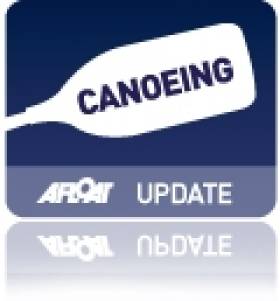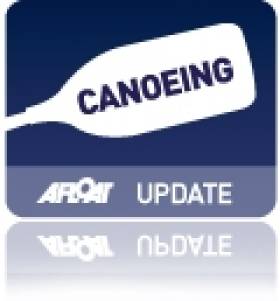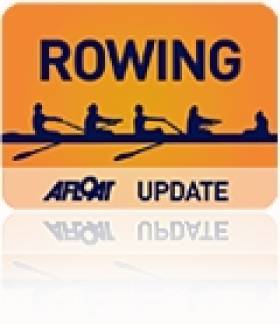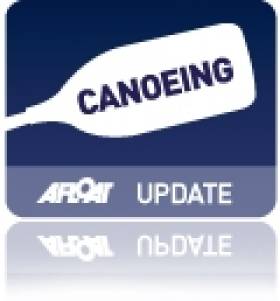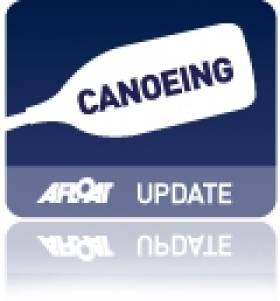Displaying items by tag: Olympics,
# CANOEING: Ireland took a creditable ninth place at the Olympic Games today when Andrzej Jezierski dominated the B Final of the C1 200 metres in the Canoe Sprint competition at Eton Dorney.
Jezierski, who had a poor start in his semi-final and missed out a place in the A Final, nailed it this time and led as he came into the closing stages. Vadim Menkov of Uzbekhistan came closest to catching the Cork-based competitor, but Jezierski won by .127 of a second.
Olympic Games – Canoe Sprint, Eton Dorney – C1 200m, B Final (places 9 to 16): 1 Ireland (A Jezierski) 44.041 seconds, 2 Uzbekhistan 44.168, 3 Hungary 44.466.
# CANOEING: A poor start cost Andrzej Jezierski dearly it the Olympic Canoe Sprint semi-finals this morning. A very tough draw in the C1 200 metres saw the Ireland competitor needing to finish in the first two of a top-class field to be sure of a final place, though the two fastest third-place losers of the three semis would also qualify. However, Jezierski struggled from the start and even his customary better second half could only secure fourth. It was the fastest of the three semi-finals. Jezierski is now set for the B Final.
The top two places in the semi-final were taken by Ivan Shtyl of Russia and Alfonso Benavidez Lopes de Ayala of Spain.
Olympic Games
Canoe Sprint – Eton Dorney – C1 200m – Semi-Final (First Two to Semi-Finals): 1 Russia (I Shtyl) 40.346, 2 Spain (A Benavidez Lopes de Ayala) 40.619; 4 Ireland (A Jezierski) 42.012.
Olympic Hopeful Jezierski Qualifies for A Final At European Canoe Sprint Championships
# CANOEING: Ireland’s hopes in Canoe Sprint at the Olympic Games received a boost today when Andrzej Jezierski qualified for the A Final at the Canoe Sprint European Championships in Zagreb. The Cork-based athlete, who will represent Ireland in the C1 200 class in London 2012, finished second in his semi-final today in that class, having placed third in his heat.
Canoe Sprint European Championships, Zagreb – Day Two (Irish interest)
Men
C1 200
Heat One (First to final; 2-7 to Semi-Final): 3 A Jezierski 40.571. Semi-Final (First Three to A Final): 1 Belarus (D Harazha) 39.770, 2 Jezierski 40.198, 3 Slovakia (L Hagara) 40.514.
# ROWING: Ireland's Sanita Puspure, who recently qualified for the Olympic Games, will compete at Henley Royal Regatta. The Old Collegians woman takes part in the World Cup in Munich this weekend.
Entries for Henley Royal Regatta (Irish interest)
Temple: Trinity
Remenham: UCD
Visitors’: Queen’s
Wyfold: Cork BC
Queen Mother: UCC/London RC
Prince Albert: Queen’s
Diamond Sculls: J Keohane (Lee Valley); C Williamson (Queen’s)
Princess Royal: S Puspure (Old Collegians)
# ROWING: Sanita Puspure is the Afloat Rower of the Month for May. The 30-year-old gave Ireland a place in the rowing programme at the Olympic Games in London with a characteristically gutsy performance which placed her fourth in the single scull at the Olympic Qualifier in Lucerne. This was the final Olympic place on offer, and she won a battle in the closing stages with Iva Obradovic of Serbia to clinch the spot. She is the deserving and popular winner of the Afloat Rower of the MonthRower of the Month awards:
The judging panel is made up of Liam Gorman, rowing correspondent of The Irish Times and David O'Brien, Editor of Afloat magazine. Monthly awards for achievements during the year will appear on afloat.ie and the overall national award will be presented to the person or crew who, in the judges' opinion, achieved the most notable results in, or made the most significant contribution to rowing during 2012. Keep a monthly eye on progress and watch our 2012 champions list grow.
# ROWING: Ireland’s Mark O’Donovan and Niall Kenny missed out on the chance of Olympic Qualification when they finished fifth in their lightweight double scull semi-final at the Olympic Qualification Regatta in Lucerne today. The race was won by Australia, but the three boats behind them finished so close together that there was a a long delay as the judges decided which two landed positions in the final. The verdict went to Austria and Bulgaria – credited with exactly the same time – with Spain losing out. Ireland had not looked likely to land one of the top three spots for most of the race.
Olympic Qualification Regatta, Lucerne, Switzerland
Men
Lightweight Double Scull – Semi-Finals (Three to A Final; rest to B Final) – Semi-Final One: 1 Hungary (Z Hirling, T Varga) 6:31.46, 2 United States (A Campbell Jr, W Daly) 6:33.77, 3 Switzerland (S Zehnder, M Schmid) 6:38.01; 4 Poland 6:41.29, 5 Sweden 6:44.72, 6 Slovenia 6:45.28. Semi-Final Two: 1 Australia (R Chisholm, T Gibson) 6:33.03, 2= Austria (P Sieber, B Sieber) 6:35.66, 2=Bulgaria (Z Karaivanov, V Vitanov) 6:35.66; 4 Spain (A Bertran Sastre, D Sigurjorsson Benet) 6:36.09, 5 Ireland (M O’Donovan, N Kenny) 6:39.18, 6 Czech Republic 6:53.74.
Women
Single Scull – Semi-Final One (Three to A Final; rest to B Final): 1 Australia (K Crow) 7:32.83, 2 Serbia (I Obradovic) 7:37.99, 3 Ireland (S Puspure) 7:41.27; 4 Norway (T Gjoertz) 7:42.55, 5 Ukraine (N Huba) 7:52.73, 6 Britain (R Gamble-Flint) 7:52.90. Semi-Final Two: 1 Denmark (FU Erichsen) 7:36.13, United States (G Stone) 7:39.48, Estonia (K Pajusalu) 7:42.79; France 7:48.85, 5 Latvia 8:02.96, 6 Bulgaria 8:03.05
Puspure in Final at Olympic Qualification Rowing Regatta
# ROWING: Sanita Puspure is just a race away from qualifying for the Olympic Games. The Ireland single sculler finished third in her semi-final this morning behind Kim Crow of Australia and Iva Obradovic of Serbia to book her place in tomorrow’s A Final.
Olympic Qualification Regatta, Lucerne, Switzerland
Women’s Single Scull – Semi-Final One (Three to A Final; rest to B Final): 1 Australia (K Crow) 7:32.83, 2 Serbia (I Obradovic) 7:37.99, 3 Ireland (S Puspure) 7:41.27; 4 Norway (T Gjoertz) 7:42.55, 5 Ukraine (N Huba) 7:52.73, 6 Britain (R Gamble-Flint) 7:52.90. Semi-Final Two: 1 Denmark (FU Erichsen) 7:36.13, United States (G Stone) 7:39.48, Estonia (K Pajusalu) 7:42.79; France 7:48.85, 5 Latvia 8:02.96, 6 Bulgaria 8:03.05
B Final Place for Jezierski in Canoe Sprint World Cup
CANOEING: New Ireland star Andrzej Jezierski qualified for the B Final at the canoe sprint World Cup in Poznan in Poland. Jezierski finished fourth in his semi-final, just over three tenths of a second off the second place which would have put him in the A Final. Jezierski booked his place for the Olympic Games at the same venue in the Olympic Qualifier on Thursday.
Canoe Sprint World Cup, Poznan, Day Two (Irish interest)
Men
C1 200 – Heat Three (1-7 and next best time to Semi-Final) 7 A Jezierski 48.652. Semi-Final (1-2 and next best time to A Final; 3-4 to B Final): 4 Jezierski 42.663.
K1 1,000m – B Final: 4 B Watkins 3:53.405
K2 200 – Heat Two (1-6 and next 3 best times to Semi-Final): 8 P Egan, M Majchrzak) 37.239. Heat Four: 7 S Marchetti, V Peirce 35.798
Women
K1 500m – C Final: 7 J Egan 2:10.730.
Jezierski Qualifies Ireland Boat for Olympic Games
# CANOEING; Ireland booked a place for a third canoeist at the Olympic Games as Andrzej Jezierski fought through difficult conditions to take second place in the Olympic Qualifier in Poznan in Poland today. The Polish man who lives and works in Cork came in just over half a second behind Hagara Lubomir of Slovakia.
Jenny Egan failed to make the final in the K1 200 metres, but there are still hopes that she will make it through in the K1 500m in which she finished seventh earlier in the day.
European Canoe Sprint Olympic Qualifier – Day Two (Irish interest)
Men – C1 200m – A Final (First Two Qualify): 1 Slovakia (L Hagara) 42.518, 2 Ireland (A Jezierski) 43.034; 3 Czech Republic (M Fuksa) 43.522, 4 Germany (S Kiraj) 43.746, 5 Romania 44.186, 6 Latvia 45.202, 7 France 45.366, 6 Georgia 45.594, 9 Hungary disqualified.
Women, K1 500m – A Final: 1 Russia (Y Kachalova) 2:00.037, 2 Norway (MV Larsen) 2:01.281, 3 Poland (K Naja) 2:01.769, 4 Austria (AR Lehaci) 2:02.801, 5 Romania (R Borha) 2:03.317, 6 Spain (A Portela) 2:03.701, 7 Ireland (J Egan) 2:04.061, 8 Sweden (A Roger) 2:05.377, 9 Netherlands (E Haaze) 2:06.489.
K1 200 – Semi-Final: 1 Italy 45.253; 6 Egan 48.641.
Egan Seventh In Olympic Qualifier A Final
#CANOEING: Jenny Egan missed out on the automatic Olympic qualification places in the women’s K1 500 metres at the European Canoe Sprint qualification event in Poznan in Poland today. The Kildare woman finished seventh in the A Final, but only the top two are certain of places in London. Some more places may become available later in the summer. Egan goes in the K1 200 semi-final later today.
European Canoe Sprint Olympic Qualifier – Day Two (Irish interest)
Women, K1 500m – A Final (two automatic places for Lodnon 2012): 1 Russia (Y Kachalova) 2:00.037, 2 Norway (MV Larsen) 2:01.281; 3 Poland (K Naja) 2:01.769, 4 Austria (AR Lehaci) 2:02.801, 5 Romania (R Borha) 2:03.317, 6 Spain (A Portela) 2:03.701, 7 Ireland (J Egan) 2:04.061, 8 Sweden (A Roger) 2:05.377, 9 Netherlands (E Haaze) 2:06.489.



























